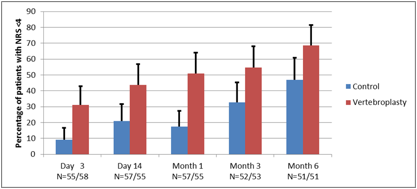Session Information
Date: Sunday, November 13, 2016
Title: Osteoporosis and Metabolic Bone Disease – Clinical Aspects and Pathogenesis - Poster
Session Type: ACR Poster Session A
Session Time: 9:00AM-11:00AM
Background/Purpose: Evaluation of efficacy and safety of percutaneous vertebral fill technique vertebroplasty in subjects with acute vertebral fracture (symptom duration less than six weeks) .
Methods: Randomized, parallel group, placebo controlled trial. The proceduralists utilized a vertebral fill cement technique, achieving cement distribution from the superior to the inferior end plate. Primary outcome measure patient rated pain intensity less than 4 (Numerical Rating Scale) measured at two weeks. Secondary outcome measures recorded at time points 3 days, 14 days, 28 days, 3 months and 6 months were functional disability (The Roland-Morris Low Back Pain and Disability Questionnaire (RDQ), The Quality of Life Questionnaire of the European Foundation for Osteoporosis (QUALEFFO. Effectiveness analyses by intention-to-treat principle. Proportions compared using a two-sided chi-squared or exact (conditional binomial) test. Changes in quality of life measures (pain/ functional disability scores) analysed using t-tests enabling comparisons with published studies. All comparisons were two-sided with a significance level of 5% considered as being statistically significant.
Results: 120 subjects were enrolled (59 control arm, 61 vertebroplasty arm). Female 73%, Male 27%. Mean age 80 years (SD 7.2) The proportion of patients achieving an NRS <4 at 14 days was 43.6% in the vertebroplasty group and 21% in the control group (p=0.011). Mean decrease in change in NRS pain score from baseline greater in the vertebroplasty group at all time points (p<0.05). Mean reduction in RDQ from baseline favoured vertebroplasty from day 14 to month 6. (p<0.05). There was minimal difference Mean QUALEFFO l between groups. Four serious adverse events occurred; 2 in the placebo group and 2 in the vertebroplasty group.
Conclusion: Percutaneous Vetebroplasty performed during the first six weeks post fracture utilizing a vertebral fill technique, is more effective than placebo in reducing pain, and improving function in patients with vertebral fracture. Serious adverse events were the same in both groups. Figure 1: Primary outcome measure – percentage (%) of patients with NRS < 4 ) all time points p<0.05) 
To cite this abstract in AMA style:
Bird P, Clark W, Diamond T, Schlaphoff G, Smerdely P, Gonski P, McNeil P. A Placebo Controlled Trial of Vertebral Fill Technique Vertebroplasty for Acute Painful Osteoporotic Fracture (VAPOUR Trial) [abstract]. Arthritis Rheumatol. 2016; 68 (suppl 10). https://acrabstracts.org/abstract/a-placebo-controlled-trial-of-vertebral-fill-technique-vertebroplasty-for-acute-painful-osteoporotic-fracture-vapour-trial/. Accessed .« Back to 2016 ACR/ARHP Annual Meeting
ACR Meeting Abstracts - https://acrabstracts.org/abstract/a-placebo-controlled-trial-of-vertebral-fill-technique-vertebroplasty-for-acute-painful-osteoporotic-fracture-vapour-trial/
